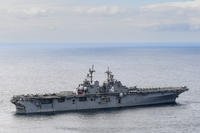The director of the military’s Joint Rapid Acquisition Cell is leaving for a private sector job as more questions arise whether rapid acquisition will continue once troops are out of Afghanistan.
Military leaders say they plan to continue the organization’s work to quickly deliver technologies and systems for commanders despite the winding down of two decade-long ground wars in Iraq and Afghanistan.
JRAC director Andrew Hunter, who is leaving DoD for a senior position with the Center for Strategic and International Studies, told reporters that rapid acquisition work will continue.
The JRAC organization is designed to respond to urgent requirements and needs from combatant commanders by finding and quickly adapting existing technologies, systems and platforms and delivering them under five years, Hunter explained.
“It is OK to keep doing this. If you go back to 2002 and 2003 there were a lot of questions about whether we can achieve this. This can be done. We’ve proven that we can do this. As people who have a lot of experience with rapid acquisition leave, some of the knowledge is perishable. However, with all the turn over, the leadership focus is that there is still interest in seeing rapid acquisition process happen,” Hunter said.
Several examples of JRAC activities include the rapid deployment of IED-detecting ground robots, counter-IED jamming devices, Mine Resistant Ambush Protected, or MRAP, vehicles. Hunter also cited the efforts to destroy Syria’s stockpile of chemical weapons aboard the MV Cape Ray in the Mediterranean as evidence of successful rapid acquisition tactics.
Among other things, the JRAC is tasked with providing a single point of contact within the Office of the Secretary of Defense for tracking immediate combat needs.
“We have worked hard with the joint staff to simplify and clarify things in order to have a sound process. We really look at requirements and determine what is achievable in a rapid time frame,” he added.
The idea for JRAC was to establish a formal system outside of the traditional acquisition process. The concept was to prioritize rapidly needed items to bypass many of the lengthy and cumbersome regulations woven into the formal acquisition process.
Citing the never-ending combatant commander demand for ISR, Hunter said rapid acquisition for those platforms is expected to last for many years into the future.
Hunter also said that the Pentagon was working with the Congressional defense committees to submit specific legislative proposals in the 2016 defense bill which will make it easier for acquisition program managers to properly focus on completing their assigned tasks.
“The proposals, that we hope will be favorably received, can reduce some of the burden on program managers. They will allow the department to do more of what DoD emphasizes and gear efforts toward what we are trying to buy and accomplish and not checking boxes or having just a compliance mentality,” Hunter added.








